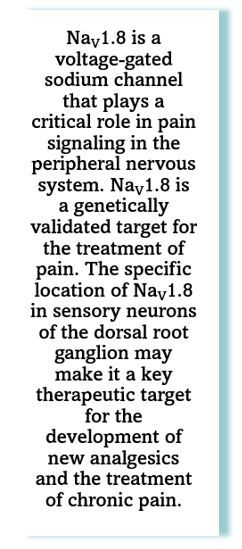- Clinical Technology
- Adult Immunization
- Hepatology
- Pediatric Immunization
- Screening
- Psychiatry
- Allergy
- Women's Health
- Cardiology
- Pediatrics
- Dermatology
- Endocrinology
- Pain Management
- Gastroenterology
- Infectious Disease
- Obesity Medicine
- Rheumatology
- Nephrology
- Neurology
- Pulmonology
Investigational Nonopioid VX-548 Reduces Moderate to Severe Post-Surgical Pain in Late-Stage Clinical Trials
Oral VX-548 has the potential to fill the gap between drugs that are tolerable but lack efficacy and opioids with therapeutic efficacy but known risks, according to Vertex.
In 2 pivotal phase 3 randomized clinical trials the investigational selective NaV1.8 inhibitor was associated with statistically significant improvement in pain intensity and clinically meaningful reduction of moderate-to-severe acute post-surgical pain compared with placebo, according to an announcement Tuesday from biotechnology company Vertex.
Following abdominoplasty or bunionectomy surgery, treatment with VX-548 resulted in a statistically significant improvement in the primary study endpoint—time-weighted sum of pain intensity difference from 0 to 48 hours (SPID48) compared with placebo as well as a clinically meaningful reduction in pain from baseline at 48 hours as measured via the Numeric Pain Rating Scale (NPRS). In the phase 3 single arm safety and effectiveness study, VX-548 was effective and well tolerated across a broad range of other surgical and nonsurgical acute pain conditions.

“The VX-548 benefit-risk profile ideally positions it to potentially fill the gap between medicines with good tolerability but limited efficacy and opioid medicines with therapeutic efficacy but known risks, including addictive potential,” Reshma Kewalramani, MD, chief executive officer and president of Vertex, said in the company statement.
Vertex plans a New Drug Application submission to the US Food and Drug Administration by the middle of 2024, according to the company.
Phase 3 program
Adult patients aged 18 to 80 years undergoing abdominoplasty (n = 1118) and bunionectomy (n = 1073) received either VX-548 (initial dose of 100 mg followed by 50 mg every 12 hours), hydrocodone bitartrate/ acetaminophen ([HB/APAP] 5 mg/325 mg orally every 6 hours over a period of 42 hours), or placebo following surgery.
Primary. Satisfying the primary endpoint, SPID48 with VX-548 was found superior to placebo in both studies, according to the news release. Following abdominoplasty, the least square [LS] mean difference in SPID48 between VX-548 and placebo was 48.4 (95% CI, 33.6 to 63.1; P <.001). After bunionectomy surgery, LS mean difference in SPID48 between VX-548 and placebo was 29.3 (95% CI, 14.0 to 44.6; P = .0002).
Key secondary. The first key secondary endpoint tested the hypothesis that VX-548 was superior to hydrocodone bitartrate/acetaminophen (HB/APAP) on SPID48 following both surgeries and was not met, according to the release. After abdominoplasty, LS mean difference between VX-548 and HB/APAP was 6.6 (95% CI, -5.4 to 18.7; P = .278) and after bunionectomy, -20.2 (95% CI, -32.7 to -7.7; P = .002).
However, time to meaningful pain relief ( ≥2-point reduction in NPRS), the second key secondary endpoint in both trials, also favored VX-548, Vertex said. The median time to the endpoint was 2 hours for abdominoplasty (nominal P <. 001) and 4 hours for bunionectomy (nominal P < .002) compared with 8 hours for placebo in both studies.
The other secondary endpoints were consistent with the primary outcome, the manufacturer stated.
In the single arm phase 3 safety study, the most common adverse events were categorized as mild to moderate, and no serious adverse events related to the study drug were reported during oral treatment with VX-548. For patients receiving VX-548, the incidence of adverse events was lower when compared with placebo (post-abdominoplasty 50.0% vs 56.3%, respectively; post-bunionectomy 31.0% vs 35.2%, respectively). Efficacy was determined using a Patient Global Assessment (PGA) at the end of the study period. Most (83.2%) patients rated VX-548 as “good, very good, or excellent” in treating pain.
“As a physician treating patients suffering from pain for many years, I know firsthand the critical need for new, efficacious and safe treatment options,” Jessica Oswald, MD, MPH, associate physician in emergency medicine and pain medicine at the University of California San Diego, and Vertex Acute Pain Steering Committee member, said in the Vertex statement. “The Phase 3 safety and efficacy across the three studies are impressive and demonstrate VX-548’s potential to change the paradigm of pain management. I look forward to the potential of having a new class of acute pain medicine — the first in more than two decades — to use as an alternative to opioids to help the millions of people impacted by acute pain.”
